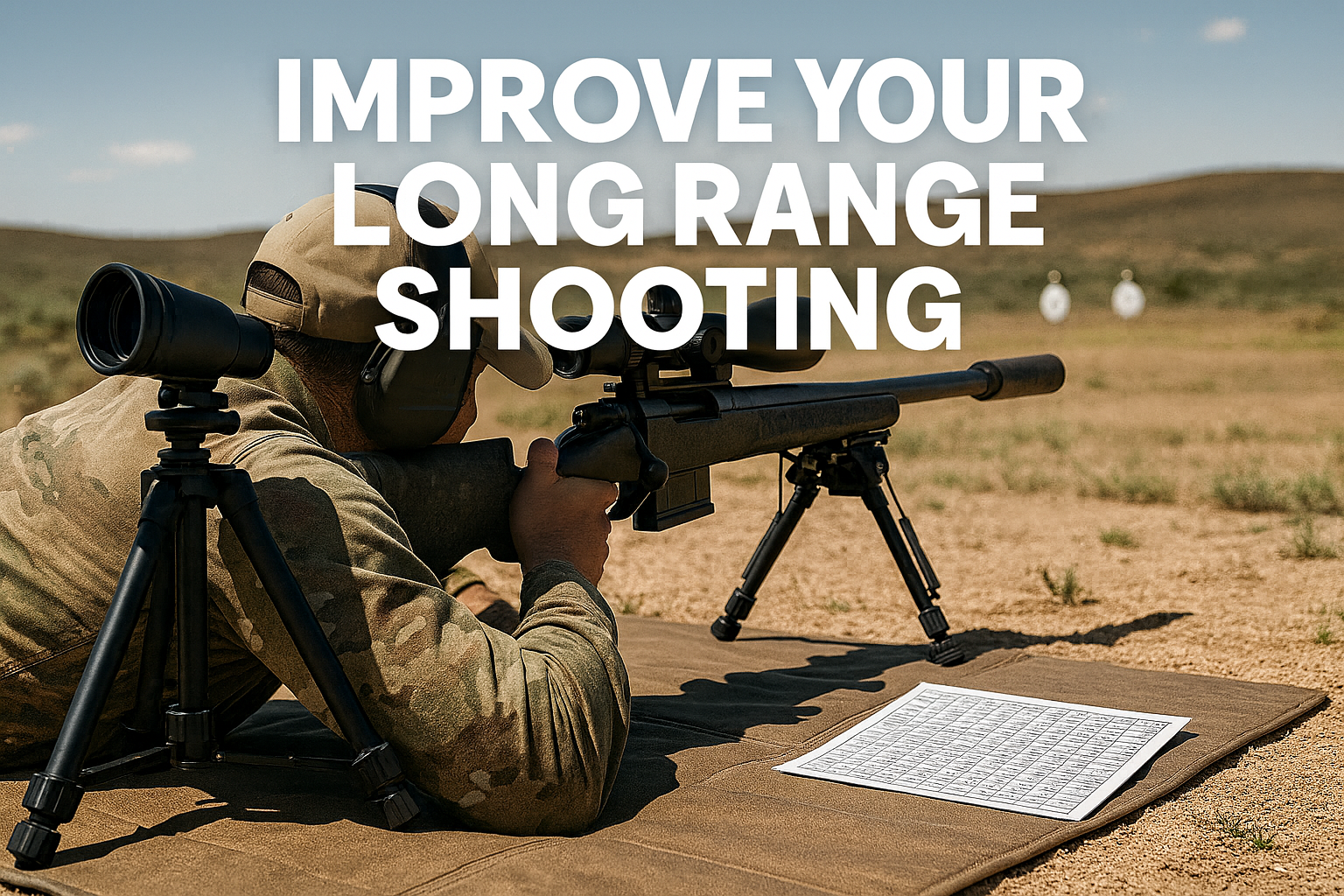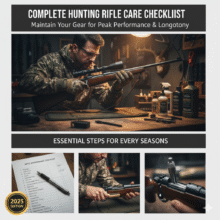Improve Your Long Range Shooting: Expert Tips & Guide

Long-range shooting isn’t just about pulling the trigger it’s an art form that combines physics, discipline, and technology. Whether you’re a seasoned marksman or a hunter expanding your range, mastering long-distance accuracy demands more than just good equipment. It requires a deep understanding of ballistics, wind reading, body mechanics, and consistent practice.
This guide breaks down how to improve your long-range shooting step by step from selecting the right rifle and scope setup to mastering trigger control and reading environmental factors. By the end, you’ll have a roadmap to hit distant targets with precision and confidence.
Table of Contents
- 1. Understand the Fundamentals of Long-Range Shooting
- 2. Choose the Right Rifle for Long-Range Accuracy
- 3. Optics: See Further, Aim Sharper
- 4. Master Ballistics and Bullet Behavior
- 5. Learn to Read the Wind
- 6. Perfect Your Shooting Position
- 7. Understand and Control Environmental Factors
- 8. Zeroing and Data Collection
- 9. Train with Purpose
- 10. Upgrade Ammunition and Reloading Practices
- 11. Use Modern Technology and Tools
- 12. Mindset and Patience: The Marksman’s Edge
- 13. Maintenance and Rifle Care
- 14. Join a Long-Range Shooting Community
- 15. Long-Range Hunting Ethics
- Conclusion
1. Understand the Fundamentals of Long-Range Shooting
Before chasing 800-yard targets, you must master the basics. Every shot, whether at 100 yards or 1,000, relies on three pillars:
A. Stability
Your shooting platform must be rock solid. Use a bipod or shooting bag to minimize movement. Even a small wobble at your rifle’s muzzle translates to several inches off target downrange.
B. Sight Alignment and Sight Picture
Ensure your reticle and target are perfectly aligned. A consistent cheek weld and eye relief help avoid parallax errors, which can cause misses at long distances.
C. Trigger Control
Jerking the trigger is one of the most common errors. Apply slow, even pressure until the shot breaks naturally. The goal is a surprise break — the shot should go off without anticipation.
2. Choose the Right Rifle for Long-Range Accuracy
Your rifle is your foundation. The right platform ensures consistent accuracy and comfort.
A. Caliber Selection
Popular long-range calibers include:
- .308 Winchester: Reliable, widely available, and excellent for up to 800 yards.
- 6.5 Creedmoor: Known for flat trajectory and minimal recoil — a favorite among precision shooters.
- .300 Winchester Magnum: Ideal for extended distances (1000+ yards) and hunting larger game.
- .22-250 or 6mm Creedmoor: Excellent for varmint and competition shooting.
Choose a caliber that matches your purpose, recoil tolerance, and ammo availability.
B. Barrel Length and Twist Rate
A longer barrel (22”–26”) generally improves muzzle velocity, helping your bullet stay supersonic longer.
Twist rate determines how well the bullet stabilizes — for example, a 1:8 twist handles heavier bullets better.
C. Trigger and Stock Upgrades
A crisp, adjustable trigger (2-3 lb pull) enhances control.
A chassis stock or precision stock adds rigidity and allows fine adjustments for length of pull and cheek height.
3. Optics: See Further, Aim Sharper
Your scope is your window to the target. Poor optics can ruin an otherwise perfect setup.
A. Magnification
For long-range shooting, a 5–25x variable scope is ideal. High magnification helps with precise aiming but keep in mind that excessive zoom narrows your field of view.
B. Reticle Type
Use MIL-DOT or MOA reticles — they provide holdover and windage references. Match your turrets to your reticle type (MIL/MIL or MOA/MOA) for consistent adjustments.
C. Parallax and Eye Relief
Adjust parallax to the target distance to prevent reticle drift. Maintain consistent eye relief (typically 3.5–4 inches) to ensure repeatable aim and avoid “scope bite.”
D. Scope Mounting
Improper scope mounting leads to missed shots. Always:
- Torque rings and bases to manufacturer specs.
- Level the reticle using a bubble level.
- Confirm zero at 100 yards before extending range.
4. Master Ballistics and Bullet Behavior
Long-range shooting is 90% math and 10% trigger time. Understanding ballistics separates precision shooters from lucky ones.
A. External Ballistics Basics
External ballistics describe how bullets behave after leaving the barrel. Key factors include:
- Muzzle Velocity: Speed of the bullet leaving the barrel.
- Ballistic Coefficient (BC): Higher BC bullets retain speed and resist wind drift better.
- Drop and Drift: Gravity and wind cause trajectory changes over distance.
B. Use a Ballistic Calculator
Apps like Strelok Pro, Applied Ballistics, or Hornady 4DOF calculate bullet drop, wind drift, and elevation corrections. Input your rifle, ammo, and environmental data for precise dope charts.
C. Chronograph Your Ammo
A chronograph measures actual muzzle velocity. Factory numbers aren’t always accurate — real data gives you more reliable ballistic calculations.
5. Learn to Read the Wind
Wind is your biggest enemy at long distances. Even a mild 5 mph crosswind can push your bullet several inches off course.
A. Observe Environmental Indicators
- Watch grass, leaves, mirage, and dust.
- Use a wind meter (anemometer) to record baseline speed.
- Note that wind often varies between you and the target — mid-range wind is most critical.
B. Estimate Wind Drift
A simple rule of thumb for 10 mph full-value wind:
- .308 Win: ~1 MOA drift per 100 yards.
- 6.5 Creedmoor: ~0.7 MOA per 100 yards.
C. Practice “Holding Off”
Instead of adjusting turrets for every shot, use your reticle’s hash marks to hold for wind corrections dynamically. This is faster and practical for real-world scenarios.
6. Perfect Your Shooting Position
A. Prone Position
The most stable long-range position. Keep your body in line with the rifle’s bore. Spread your legs slightly and pull your toes outward to absorb recoil.
B. Benchrest or Bipod Setup
Use a rear sandbag or squeeze bag to fine-tune elevation. Avoid muscle tension; let the rifle rest naturally on support.
C. Follow-Through
After firing, stay on the rifle and observe your shot impact. Don’t lift your head — this habit helps spot impacts and make quick corrections.
7. Understand and Control Environmental Factors
Shooting conditions change minute by minute.
A. Temperature
Higher temperatures increase air pressure, reducing bullet drop slightly. Always note the temperature when recording data.
B. Altitude
At higher altitudes, air is thinner — bullets experience less drag and fly flatter. Adjust your dope accordingly.
C. Humidity and Barometric Pressure
Though minor, these factors can shift point of impact at extreme ranges. Log them in your ballistic app for more precision.
8. Zeroing and Data Collection
Zeroing your rifle properly is the backbone of consistency.
A. Start at 100 Yards
Always confirm your 100-yard zero before stretching distance. Adjust turrets until the point of impact matches the crosshair.
B. Record Data
At each distance (200, 400, 600, etc.), note:
- Elevation (MOA or MIL)
- Windage corrections
- Environmental conditions
Build a DOPE (Data On Previous Engagements) card — your personal shot reference for future sessions.
C. Verify with Real Targets
Steel plates or paper targets confirm data beyond calculators. Actual bullet flight may vary slightly due to barrel harmonics and environmental differences.
9. Train with Purpose
Practice doesn’t make perfect — perfect practice does.
A. Dry Fire Practice
Train trigger control and sight alignment without live rounds. Focus on smooth trigger breaks and follow-through.
B. Range Time Routine
Structure your range sessions:
- Confirm zero.
- Practice at multiple distances.
- Record shot groups.
- Analyze misses — ask why it missed.
C. Cold Bore Shots
The first shot from a cold barrel often differs from subsequent shots. Track cold bore data — it’s especially important for hunters.
D. Shooting Drills
Try:
- Dot drills for precision.
- Positional shooting (kneeling, sitting, standing).
- Timed drills to simulate hunting or tactical stress.
10. Upgrade Ammunition and Reloading Practices
A. Match-Grade Ammo
For factory loads, choose match-grade or premium hunting ammo from brands like Hornady, Federal, or Berger. Consistency in bullet weight and powder charge matters.
B. Handloading
Reloading lets you fine-tune performance. Adjust powder charges, seating depth, and bullet type to your rifle’s preferences. Record your loads meticulously.
C. Consistency Over Speed
Chasing maximum velocity often sacrifices accuracy. Focus on consistent group size and extreme spread under 20 fps for best long-range results.
11. Use Modern Technology and Tools
Modern shooters have incredible tools at their disposal.
- Laser Rangefinders: Give exact distances, reducing estimation errors.
- Weather Meters: Feed accurate data into ballistic apps.
- Kestrel Devices: Combine wind, altitude, and ballistic calculations in one handheld tool.
- Smart Scopes: Systems like the Sig Sauer BDX sync with rangefinders to auto-adjust reticles.
While technology helps, remember: it supports — not replaces — your fundamentals.
12. Mindset and Patience: The Marksman’s Edge
Long-range shooting rewards patience, focus, and discipline.
Success comes from consistency, not luck.
- Stay Calm: Anxiety or excitement leads to poor trigger control.
- Log Every Session: Patterns emerge over time.
- Accept Variables: Wind gusts, mirage, and humidity can’t always be perfect — adapt, don’t react.
The more you shoot, the more your body and mind synchronize with your rifle.
13. Maintenance and Rifle Care
A precision rifle is like a musical instrument — it performs best when maintained properly.
A. Cleaning Routine
After every session:
- Clean bore with solvent and patches.
- Use a bore guide to prevent crown damage.
- Wipe bolt and action with lubricant.
B. Torque Checks
Periodically verify torque on scope rings, mounts, and action screws. Loose hardware causes shot inconsistency.
C. Barrel Life
Most precision barrels last 2,000–4,000 rounds depending on caliber. Track round count and replace when accuracy starts degrading.
14. Join a Long-Range Shooting Community
Learning accelerates when shared.
Join local PRS (Precision Rifle Series) clubs or online forums. Discuss load data, share dope cards, and learn from others’ experiences.
You’ll find that even elite shooters continually learn new tricks.
15. Long-Range Hunting Ethics
If you’re using long-range shooting for hunting, ethical responsibility comes first.
- Know Your Limits: Only take shots you’re 100% confident in hitting cleanly.
- Practice Real Scenarios: Simulate field positions and unpredictable wind.
- Follow Up Responsibly: Always verify your hit and track wounded game.
Accuracy isn’t just skill — it’s respect for the animal.
Conclusion
Improving your long-range shooting isn’t a weekend task it’s a journey. The best shooters don’t rely solely on equipment; they rely on knowledge, consistency, and mindset.







